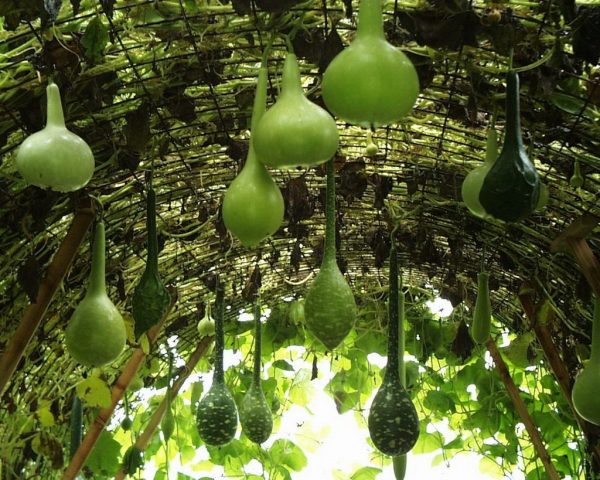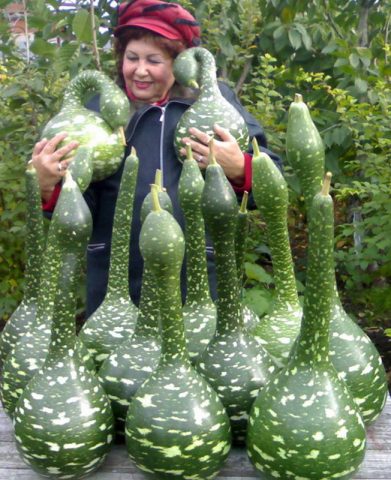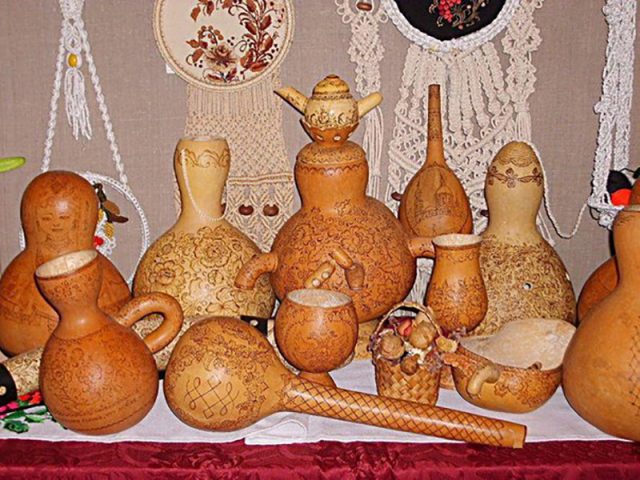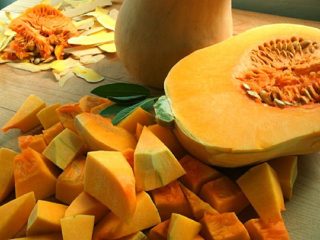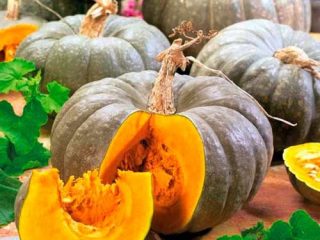Content
The bottle gourd has only recently appeared in Russian vegetable gardens and orchard plots. And they became interested in her not for the tasty fruits and bountiful harvest. The shape of the fruit attracted the attention of gardeners and their main purpose - the manufacture of decorative handicrafts. The Russians wanted to grow such a pumpkin with their own hands, and then make a decoration from it for their home or a gift for friends.
Description of the variety
Bottle gourd with different names - Vietnamese zucchini, Indian cucumber, Gorlyanka, Calabas - comes from Africa, has up to 7 species, differing in leaves, seed color, fruit shape, flower size. It represents an annual liana, as evidenced by the description of this tropical culture:
- faceted stem, covered with fluff, gives daily growth up to 15-20 cm, grows up to 15 m long;
- leaves are large, pentagonal, with a wavy surface, slightly pubescent;
- flowers are small, white, on long petioles, located in the axils of the leaves, bloom at night;
- fruits of an unusual shape, can grow up to 2-2.5 m in length.
The bottle gourd is grown to produce fruits that have an unusual shape. When fully ripe, they do not rot, but dry out so that they can be used for different purposes.
Description of fruits
The fruits of the bottle gourd are smooth and firm, at the beginning of ripening they look like long cucumbers, and then they can take on different shapes:
- flattened;
- serpentine;
- spherical;
- pear-shaped.
You can give the pumpkin a very specific look. To do this, the young ovary is placed in a wooden device, the shape of which the fruit takes in the process of growth.
Only young fruits of bottle gourd with a length of 20-40 cm with a delicate pulp structure and a piquant taste are used for food. It resembles the taste of zucchini, can be used to prepare the same dishes.
With further growth of the vegetable, the pulp dries up, the peel becomes dense, light and waterproof. Various decorative items are made from such fruits:
- all kinds of dishes;
- musical instruments;
- toys;
- boxes;
- candlesticks;
- smoking pipes.
You can weave baskets, rugs, hats from strong stems of bottle gourd.
Species characteristics
Since bottle gourd is a tropical vegetable, and it lives only one summer, it has not yet had time to adapt to frost and requires a lot of heat, sun to grow and does not tolerate cold drafts at all.
This crop is tolerant of drought, but in order to form a good harvest, it must be watered as soon as the soil is dry.
But strong immunity helps to resist many diseases (powdery mildew, mosaic, anthracnose, etc.) and not be attacked by pests.
Up to 10 fruits can be harvested from one bush. Gardeners are advised to reduce their number by breaking off the ovaries in order to get fewer fruits, but larger in size.
The benefits and harms of bottle gourd
The rich vitamin and mineral composition and low calorie content of the fruit of the bottle gourd make it recommended for many diets. Only very young pumpkins are eaten.
Seed oil is used in medicine and cosmetology. Infusions of leaves, fruits and stems, prepared according to recipes of traditional medicine, help in:
- strengthening immunity;
- normalization of metabolism;
- stabilization of the heart;
- lowering cholesterol levels;
- binding free radicals and removing them from the body.
The harm that the use of bottle pumpkin can bring to the body is an individual intolerance to the product.
Growing bottle gourd
In the climatic conditions of central Russia, lagenaria can only be grown by seedlings and in a greenhouse or greenhouse.
First, you should prepare the soil in which the seeds will be planted, and a container for seedlings. There is no exact recommendation on which soil is more suitable for growing seedlings of bottle pumpkin lagenaria. Gardeners differ on this issue. At your discretion, you can act in one of the following ways:
- take land from your site if it is considered fertile enough;
- buy a balanced substrate in the store;
- make the mixture yourself by mixing turf, humus and sand with the addition of ash or charcoal.
Lagenaria bottle gourd seeds are large in size with a dense skin. Before planting, they should be soaked in hot water (+450C) for two days or put in a growth stimulator for a day. Then wrap in wet gauze or put in damp sawdust. The air temperature should be room temperature. After about a week, biting will occur, which is a signal to plant bottle gourd seeds for seedlings.
To do this, proceed as follows:
- Drainage and prepared soil are placed in the seedling container.
- To a depth of 4 cm, seeds are immersed with a sprout down, lightly watered.
- They create a greenhouse effect, covered with film or glass, until full-fledged sprouts appear.
Further, the film is removed, and when strong seedlings grow, they are planted in open ground. It takes about one month to grow bottle gourd seedlings from seeds. At the end of May, the lagenaria should be transplanted to a permanent place where it will give its bottle fruits.
It is better to choose a landing site near a fence or a wall, which in the future will serve as a support for the stems of the lagenaria. It should be remembered that the bottle gourd loves the sun and warmth. Top dressing must be done every 10 days. And when the stems reach 3 m in length, you need to stop fertilizing the bush.
How to dry bottle gourd
If the bottle gourd was grown for crafts, as in the photo below, then it must be properly dried. To do this, proceed as follows:
- The fruits are cut, leaving only the tail.
- They wash well from dust and dirt with soap, wipe dry.
- Leave in the fresh air or in a well-ventilated room without direct sunlight.
- After a week, the fruits are checked: they should change color and become hard.
- Now they are transferred for a long time (up to six months) in a dark room for final drying.
Fruits need to be turned over once every 3-4 days for even drying and checked in order to remove spoiled and with traces of mold in time. Confirmation that the bottle gourd is dry is the sound of dry seeds when shaken. When the seeds have thundered, the top is cut off, the entrails are taken out and left until final drying.
How to cook bottle gourd
In terms of its qualities, bottle gourd resembles the zucchini common in Russian regions. It is usually cooked like a marrow, and in dishes it behaves in about the same way. Here are some proven recipes.
Lagenaria caviar
For cooking you need:
- bottle pumpkin - 1 kg;
- onions - 300 g;
- tomatoes - 400 g;
- vegetable oil - 150 g;
- salt, pepper - to taste.
Preparation:
- Pumpkin, tomatoes, onions are peeled and cut into small cubes.
- First, onions are sautéed in hot oil.
- Then add tomatoes to the onion and fry over low heat for 10-15 minutes.
- Pieces of pumpkin are combined with the resulting mass, spices are added and stewed to the desired consistency. Usually a mass similar to caviar is obtained.
This dish is consumed cold, spread on slices of bread.
Pancakes
This dish is prepared in much the same way as zucchini pancakes. But, whether they are similar to each other, everyone can determine on their own taste.
Required products:
- bottle pumpkin - 400 g;
- celery - 100 g;
- flour - 1 tbsp.;
- raw egg - 1 pc .;
- refined oil - 3 tbsp. l .;
- salt - on the tip of the knife.
Preparation:
- Vegetables are washed, peeled and grated on a coarse grater.
- Add egg, flour, salt and mix everything.
- Fried on both sides in a preheated pan with butter, turning over.
Pancakes turn out to be very tender and a little spicy in taste.
Hungarian recipe
What do you need:
- fruits of lagenaria - 0.5 kg;
- red bell pepper - 100 g;
- onions - 2 pcs.;
- pork fat - 50 g;
- sour cream - 2 tbsp. l .;
- broth - 1 tbsp.;
- sunflower oil - 50 g;
- flour - 2 tbsp. l .;
- spices to taste.
How to cook:
- The vegetables are cut into pieces and fried with lard.
- The broth is added and stewed until the liquid evaporates.
- Flour is separately fried in oil and mixed with vegetables.
- Add sour cream and spices, cover and stew until tender.
At the exit, a vegetable gravy is obtained, which can be served as an independent dish with breadcrumbs or added to main courses.
Conclusion
The bottle gourd conquers not only temperate climates, but also the hearts of gardeners. For those who love to create with their own hands, this tropical vegetable is a gift from nature for the manifestation of their creativity with the application of agronomic skills.
